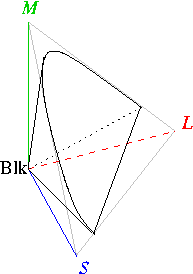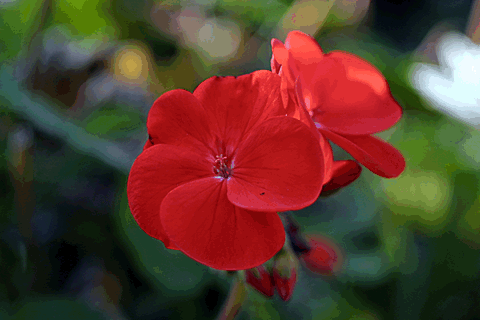|
Bezold–Brücke Shift
The Bezold–Brücke shift or luminance-on-hue effect is a change in hue perception as light intensity changes. As intensity increases, spectral colors shift more towards blue (if below 500 nm) or yellow (if above 500 nm). At lower intensities, the red/green axis dominates. This means that reds become more yellow with increasing brightness. Light may change in the perceived hue as its brightness changes, despite the fact that it retains a constant spectral composition. It was discovered by Wilhelm von Bezold and M.E. Brücke. The shift in the hue of the colors that occur as the intensity of the corresponding energy change is materially increased, except in some cases like the change for certain invariable hues (approximating the psychologically primary hues). Both Bezold & Brücke worked on the Bezold-Brücke effect and gave important contributions in the field of optical illusions. This effect is a problem for simple HSV-style color models, which treat hue and intensi ... [...More Info...] [...Related Items...] OR: [Wikipedia] [Google] [Baidu] |
Spectral Color
A spectral color is a color that is evoked by ''monochromatic light'', i.e. either a single wavelength of light in the visible spectrum, or by a relatively narrow band of wavelengths (e.g. lasers). Every wavelength of visible light is perceived as a spectral color; when viewed as a continuous spectrum, these colors are seen as the familiar rainbow. All colors that do not qualify as a spectral color are called ''non-spectral colors'' or ''extra-spectral colors''. Extra-spectral colors cannot be evoked with a single wavelength of light, but rather by a combination of wavelengths. Likewise, light comprising several wavelengths cannot evoke a spectral color. In color spaces In color spaces which include all, or most spectral colors, they form a part of boundary of the set of all real colors. When considering a three-dimensional color space (which including luminance), the spectral colors form a surface. When excluding luminance and considering a two-dimensional color space (c ... [...More Info...] [...Related Items...] OR: [Wikipedia] [Google] [Baidu] |
Wilhelm Von Bezold
Johann Friedrich Wilhelm von Bezold (June 21, 1837 – February 17, 1907) was a German physicist and meteorologist born in Munich, Kingdom of Bavaria. He is best known for discovering the Bezold effect and the Bezold–Brücke shift. Bezold studied mathematics and physics at the University of Munich and the University of Göttingen. He taught meteorology in Munich from 1861, becoming a professor in 1866. In 1868 he began teaching at the Technical University of Munich. In 1875, he was named a member of the Bavarian Academy of Sciences. From 1885 to 1907 director of the Prussian Institute of Meteorology at the University of Berlin. As a scientist, he was mainly interested in the physics of the atmosphere, and he contributed much to the theory of electrical storms. Bezold was one of the early researchers of atmospheric thermodynamics. He considered pseudo-adiabatic processes describing air as it is lifted, expands, cools, and eventually condenses and precipitates its water vapo ... [...More Info...] [...Related Items...] OR: [Wikipedia] [Google] [Baidu] |
HSV Color Space
HSL (for hue, saturation, lightness) and HSV (for hue, saturation, value; also known as HSB, for hue, saturation, brightness) are alternative representations of the RGB color model, designed in the 1970s by computer graphics researchers to more closely align with the way human vision perceives color-making attributes. In these models, colors of each ''hue'' are arranged in a radial slice, around a central axis of neutral colors which ranges from black at the bottom to white at the top. The HSL representation models the way different paints mix together to create color in the real world, with the ''lightness'' dimension resembling the varying amounts of black or white paint in the mixture (e.g. to create "light red", a red pigment can be mixed with white paint; this white paint corresponds to a high "lightness" value in the HSL representation). Fully saturated colors are placed around a circle at a lightness value of ½, with a lightness value of 0 or 1 corresponding to fully bla ... [...More Info...] [...Related Items...] OR: [Wikipedia] [Google] [Baidu] |
Color Model
A color model is an abstract mathematical model describing the way colors can be represented as tuples of numbers, typically as three or four values or color components. When this model is associated with a precise description of how the components are to be interpreted (viewing conditions, etc.), taking account of visual perception, the resulting set of colors is called "color space." This article describes ways in which human color vision can be modeled, and discusses some of the models in common use. Tristimulus color space One can picture this space as a region in three-dimensional Euclidean space if one identifies the ''x'', ''y'', and ''z'' axes with the stimuli for the long-wavelength (''L''), medium-wavelength (''M''), and short-wavelength (''S'') light receptors. The origin, (''S'',''M'',''L'') = (0,0,0), corresponds to black. White has no definite position in this diagram; rather it is defined according to the color temperature or white balance as desired or ... [...More Info...] [...Related Items...] OR: [Wikipedia] [Google] [Baidu] |
Color Appearance Model
A color appearance model (CAM) is a mathematical model that seeks to describe the perceptual aspects of human color vision, i.e. viewing conditions under which the appearance of a color does not tally with the corresponding physical measurement of the stimulus source. (In contrast, a color model defines a coordinate space to describe colors, such as the RGB and CMYK color models.) A uniform color space (UCS) is a color model that seeks to make the color-making attributes perceptually uniform, i.e. identical spatial distance between two colors equals identical amount of perceived color difference. A CAM under a fixed viewing condition results in a UCS; a UCS with a modeling of variable viewing conditions results in a CAM. A UCS without such modelling can still be used as a rudimentary CAM. Color appearance Color originates in the mind of the observer; “objectively”, there is only the spectral power distribution of the light that meets the eye. In this sense, ''any'' color perce ... [...More Info...] [...Related Items...] OR: [Wikipedia] [Google] [Baidu] |
Helmholtz–Kohlrausch Effect
The Helmholtz–Kohlrausch effect (after Hermann von Helmholtz and V. A. Kohlrausch) is a perceptual phenomenon wherein the intense saturation of spectral hue is perceived as part of the color's luminance. This brightness increase by saturation, which grows stronger as saturation increases, might better be called chromatic luminance, since "white" or achromatic luminance is the standard of comparison. It appears in both self-luminous and surface colors, although it is most pronounced in spectral lights. Lightness Even when they have the same luminance, colored lights seem brighter to human observers than white light does. The way humans perceive the brightness of the lights is different for everyone. When the colors are more saturated, our eyes interpret it as the color's luminance and chroma. This makes us believe that the colors are actually brighter. An exception to this is when the human observer is red-green colorblind, they cannot distinguish the differences between the ligh ... [...More Info...] [...Related Items...] OR: [Wikipedia] [Google] [Baidu] |
Opponent Process
The opponent process is a color theory that states that the human visual system interprets information about color by processing signals from photoreceptor cells in an antagonistic manner. The opponent-process theory suggests that there are three opponent channels, each comprising an opposing color pair: red versus green, blue versus yellow, and black versus white (luminance). The theory was first proposed in 1892 by the German physiologist Ewald Hering. Color theory Complementary colors When staring at a bright color for awhile (e.g. red), then looking away at a white field, an afterimage is perceived, such that the original color will evoke its complementary color (green, in the case of red input). When complementary colors are combined or mixed, they "cancel each other out" and become neutral (white or gray). That is, complementary colors are never perceived as a mixture; there is no "greenish red" or "yellowish blue", despite claims to the contrary. The strongest color con ... [...More Info...] [...Related Items...] OR: [Wikipedia] [Google] [Baidu] |
Purkinje Effect
The Purkinje effect (; sometimes called the Purkinje shift, often incorrectly pronounced ) is the tendency for the peak luminance sensitivity of the eye to shift toward the blue end of the color spectrum at low illumination levels as part of dark adaptation. In consequence, reds will appear darker relative to other colors as light levels decrease. The effect is named after the Czech anatomist Jan Evangelista Purkyně. While the effect is often described from the perspective of the human eye, it is well established in a number of animals under the same name to describe the general shifting of spectral sensitivity due to pooling of rod and cone output signals as a part of dark/light adaptation. This effect introduces a difference in color contrast under different levels of illumination. For instance, in bright sunlight, geranium flowers appear bright red against the dull green of their leaves, or adjacent blue flowers, but in the same scene viewed at dusk, the contrast is rever ... [...More Info...] [...Related Items...] OR: [Wikipedia] [Google] [Baidu] |
Abney Effect
The Abney effect or the purity-on-hue effect describes the perceived hue shift that occurs when white light is added to a monochromatic light source. The addition of white light will cause a desaturation of the monochromatic source, as perceived by the human observer. However, a less intuitive effect of the perceived white light addition is the change in the apparent hue. This hue shift is physiological rather than physical in nature. This variance of hue as a result of the addition of white light was first described by the English chemist and physicist Sir William de Wiveleslie Abney in 1909, although the date is commonly reported as 1910. A white light source can be created by the combination of red, blue, and green light. Abney demonstrated that the cause of the apparent change in hue was the red and green light that comprised this light source, and that the blue light component had no contribution to the Abney effect.W. de W. Abney. “On the Change in Hue of Spectrum Colo ... [...More Info...] [...Related Items...] OR: [Wikipedia] [Google] [Baidu] |




